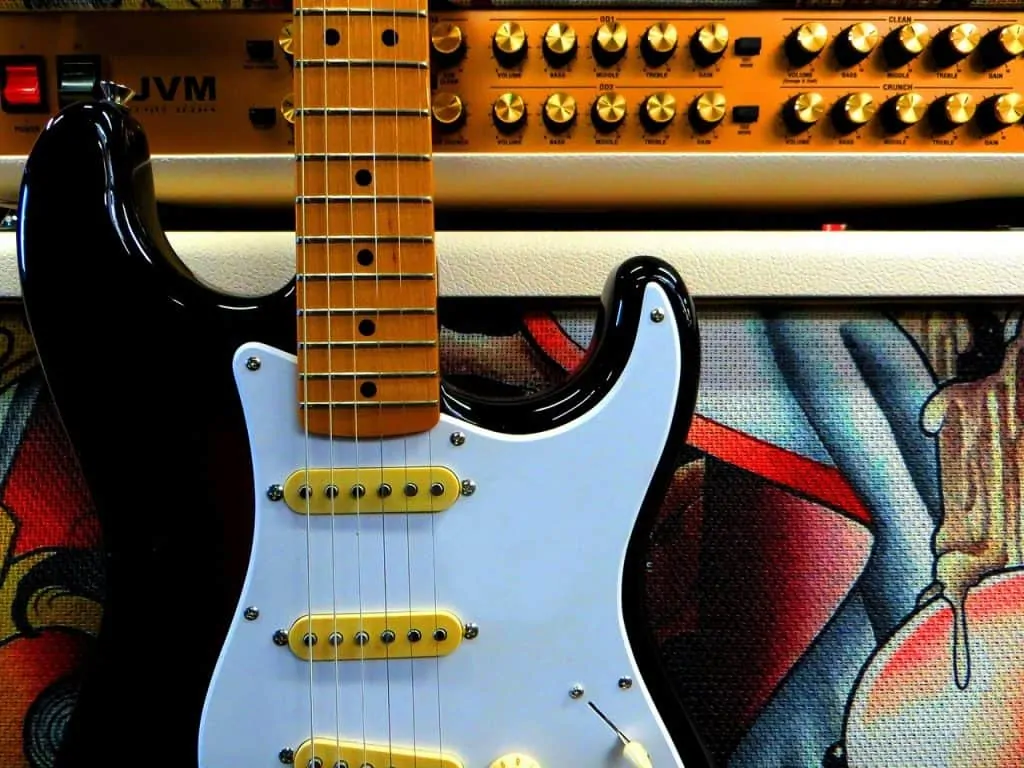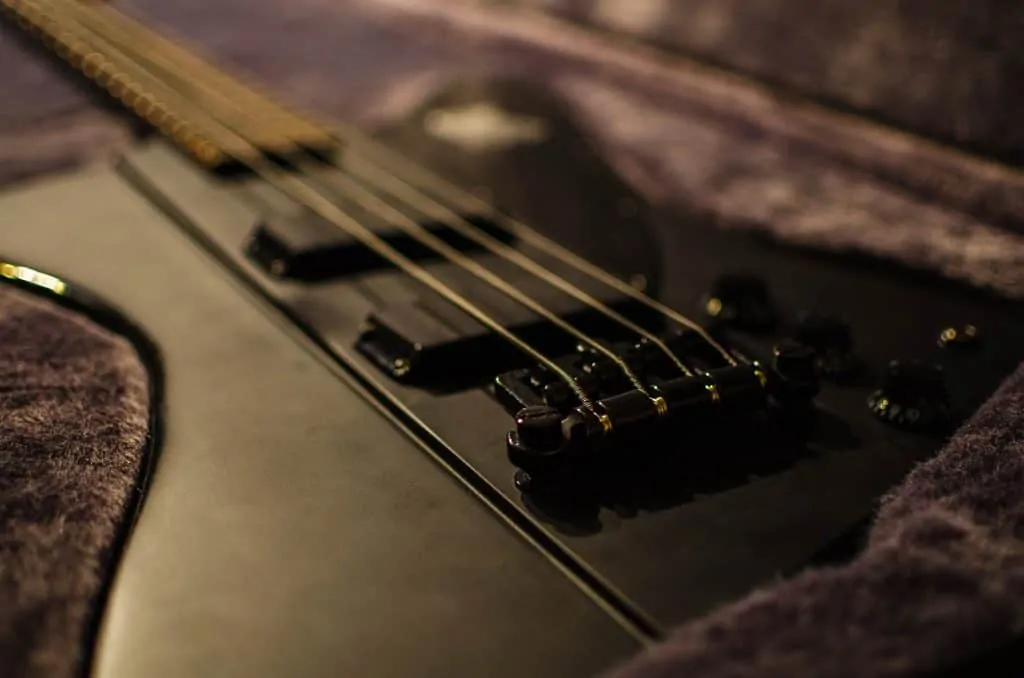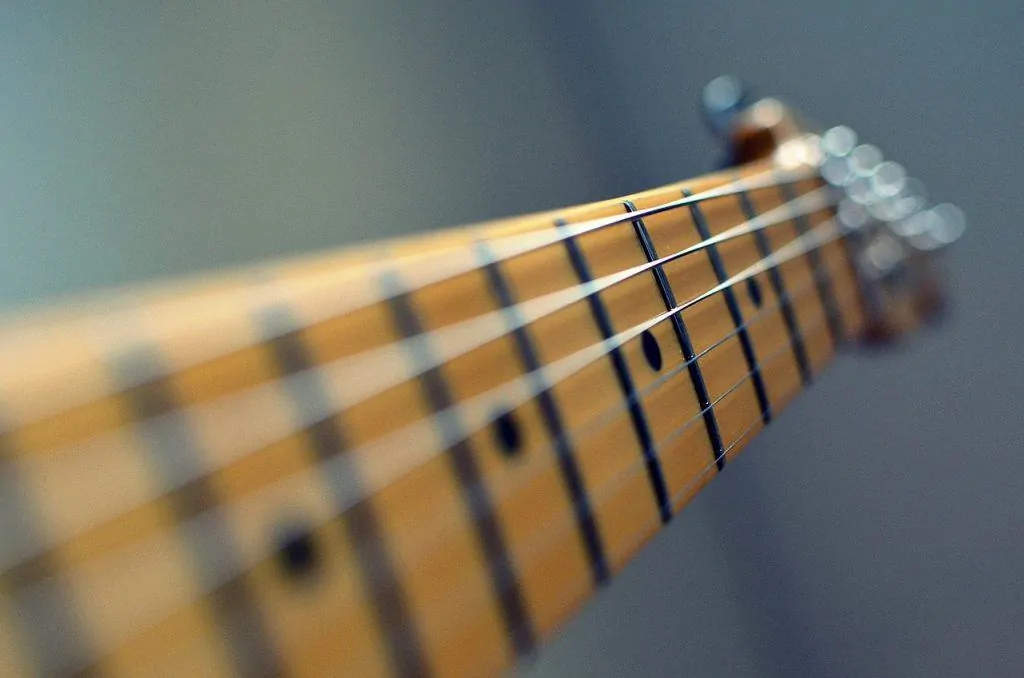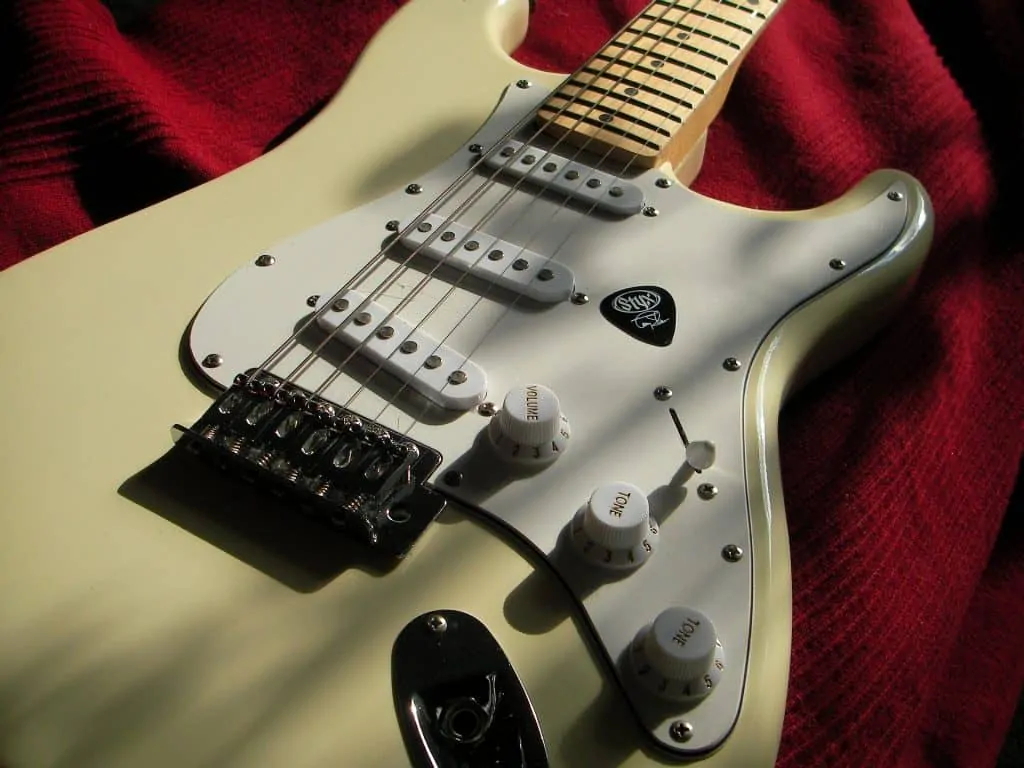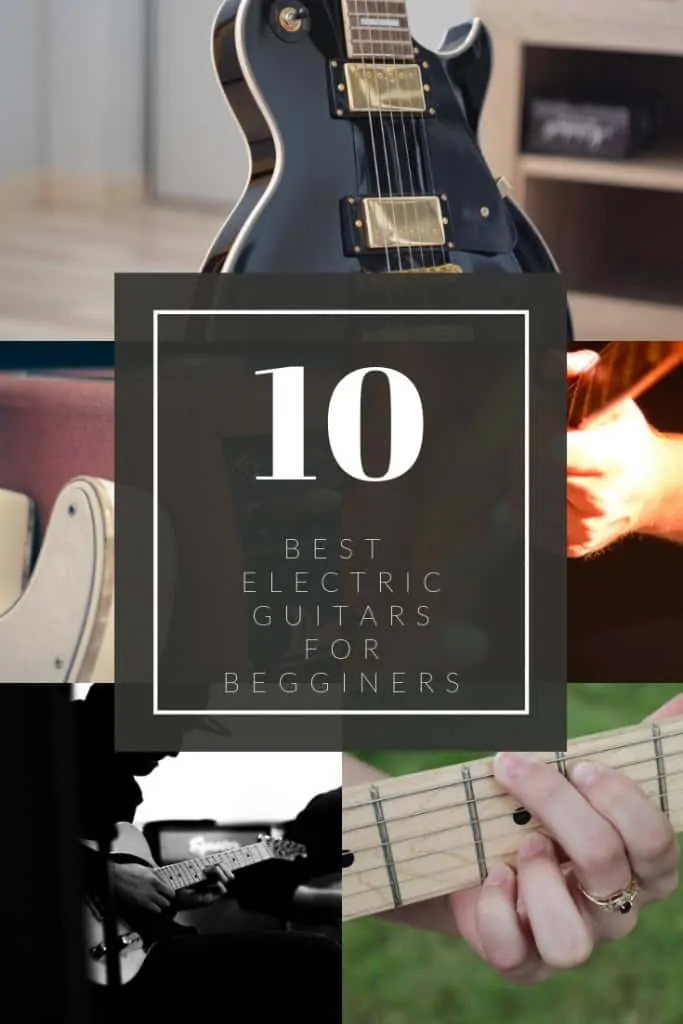I’ve heard you want to play some electric guitar. Well, all right, then. I’m here to help you pick the perfect electric guitar for you if you’re on a budget and want to learn.
This Beginners Guitar HQ guide is aimed both for beginner and people looking to save some money. If you don’t want to invest large amounts of your wallet it doesn’t mean you can’t have something good. You just need to know where to look.
Electric guitars are a great instrument. They are versatile, both powerful and sweat; they are dynamic, both strong and mellow; and they are friendly, good for composing, playing live like a good, or learning how to play guitar.
If, however, you’re still looking for the advantages of an electroacoustic guitar, you can take a look at this guide about the best budget acoustic-electric guitars you could be buying right now.
Contents
How “budget” are we talking about?
First of all, let’s make something clear. If you’re a beginner, and I’m guessing you are because you’re reading this article, then you probably don’t want to spend too much on an electric guitar. In fact, any big investment will go to waste in your hands as you’re just learning how to play guitar.
As you go to mid and top-tier guitars, you’ll be finding $$$$ prices. Again, that’s not my idea for you, though, as I understand you might not have that power or, simply, you might not want to spend it. And that’s okay because you can still sound very good with what I’m pointing out.
So, instead of a triple zero price, I’ll be talking about mid $$$ prices. So about the level of a mid-range Android phone.
Additionally, I’ll share with you some amplifier options so you can complete your beginner’s rig. If you want to know about pedals, modulators and more, please leave your comment below as I’ll be writing that guide soon enough.
It all means I’m guiding you to budget, quality, friendly, and easy to play electric guitars. Moreover, I’m telling you everything you need to know to buy the perfect guitar for you.
We’re looking for good, easy-to-play, and budget-friendly electric guitars.
Following this guide, you will learn:
- A brief history of electric guitars, where do they come from?
- What is an electric guitar;
- How does an electric guitar works;
- What to look for in a beginner electric guitar;
- The top beginner electric guitars;
- The ideal budget rig for your electric guitar;
- Final Considerations.
In the meantime, here’s what you’re looking at:
Where do electric guitars come from?
Let me give you some context first. I promise everything I say will help you play better.
According to How Stuff Works, engineers and scientists began experimenting with electrical instruments powered with electricity- in the 1800s. First results were pianos and music boxes.
Later on, the radio industry developed amplified instruments in the 1920s. Lloyd Loar, a Gibson Guitar Company engineer, was one of the first innovators. He developed electric pickups for string bass and viola. The pickup translated the string’s vibrations into a signal the amplifier could use.
In 1928, the Stromberg-Voisinet company made the first electric guitar using Loar’s original pickup design. Only in this case, the pickup used the vibrations from the soundboard.
Early electric guitars used pickups that amplified the natural sound of the guitar, much like an electroacoustic guitar. By the 1940s, researches began exploring electromagnet pickups that could register string vibration from the whole fretboard.
Adolph Rickenbacker created the first electric guitar with an electromagnetic pickup in 1932, and he called it “Frying Pan.” However, this model was an Hawaiian-style guitar, whereas “Spanish” electric guitars were slowly accepted.
In 1939, Charlie Christian created the first electric guitar as we would know it today. In 1950, Leo Fender, who used to be a radio repairman, created a solid body electric guitar, the Telecaster -although it was first named the “Fender Esquire.”
Two years later, in 1952, Les Paul, a famous acoustic guitar player, build their first solid-body electric guitar, the Gibson Les Paul.
Both models were the frits commercially successful solid-body electric guitars.
A modern Gibson Les Paul electric guitar.
These electrical instruments made with solid materials like rosewood and maple don’t have feedback problems like hollow-body guitars. Plus, they had greater sustain. Which is why early rockstars adopted both the Les Paul and the Stratocaster and gave them a permanent place in music culture. I’m talking about Keith Richards, blues’ king Eric Clapton, or Les Paul.
As technologies advanced, guitar companies found new ways to make electric guitars sing.
In 1954, Fender created the Fender Stratocaster, which is a more versatile Telecaster. Even more rockers started using Les Paul’s and Fender models, musicians like Slash, Pink Floyd’s David Gilmour, and Van Halen.
Most guitars you see out there are nowadays are inspired in the Stratocaster. So I hope it doesn’t come as a surprise when I reveal the guitars we’re looking for belong to the Fender series. They are what we’re looking for: friendly, easy-to-play, and, if we know what we’re looking for, cheap.
Before we go on, though, I’d like you to take a look at the video below. Recognizing the difference between a Gibson Les Paul and a Fender Stratocaster and knowing which one would suit you best is of utmost importance.
How does an electric guitar work
Electric guitars define the character and tone of rock music and have been doing so since the mid 20th Century. It’s only fair to understand how they work and, thus, understanding what to look for in these instruments.
Learning how electric guitars work will help you combine amplification, pedals, and modulators to create a variety of tone and sound to compose music, practice, and play.
An electric guitar has six strings, tunning pecks, a long neck, and frets. They might be hollow or semi-hollow, however, popular guitars have solid-bodies. Magnetic pickups produce the electric sound, which you can control with the guitar’s knobs. More so, if you play the guitar unplugged, it barely produces a sound because it doesn’t have a soundboard or a hollow body.
The scientific site Explains that Stuff adds electric guitars with electromagnetism. Playing the strings changes the magnetic field within the guitar and induces electricity. Furthermore, when the coil of wire is fed with electricity, they generate magnetic fields around them.
So, cutting to the chase, the guitar’s metal strings produce electricity as you move them. The pickups are electricity-generating devices with hundred of magnets generating magnetic fields. The magnetic field then passes through the strings and create an electrical current that goes to the amp through the output.
Now that we know about this, let’s review the most important aspects of the instruments so we can progress onto what to look for in electric guitars. In essence, we’re discussing every aspect that contributes to the quality of the electric guitar and, hence, the sound it produces.
The quality of the electric guitar’s pickups might be the most important factor to consider.
Electric guitars’ bodies
Electric guitars have three basic body styles, each one with its own features.
- Solid body: it’s the most common one and its made from solid wood. Solid guitars have standard desings and their body is usually decorated.
- Hollow body: some electric guitars have a hollow body like an acoustic guitar. They produce more resonance and depend much more on the quality of the wood for the quality of the sound. The tone these instruments offer is both rich and profound.
- Semi-hollow: a semi-hollow body also offers the resonance of a hollow body. However, these guitas has a solid center to lend for sustain and cut down feedback. The result is a warmer tone and a longer sustain.
Foo Fighter’s Dave Grohl uses a semi-hollow Gibson electric guitar. You can see it on the video below:
Neck construction
The neck includes the fretboard and the headstock where the tuners are installed. It also has a metal truss rod that keeps the neck straight and may be adjusted to maintain the pitch.
Most companies build rosewood, ebony, or maple necks. The fretboard is always made of the same wood as the neck.
Most necks are shaped like a “U” or a “C.” Its design influences the playability of the guitar.
There’re three common types of neck constructions:
- Bolt-on: these are bolted on the guitar’s body, and it’s the most cost-effective construction method. Hence, it lowers the price of the guitar and facilitates neck repairs and customizations. On the downside, they have lower sustain and resonance. Most Fender guitars have this characteristic.
- Set-neck: the neck is glued to the guitar. It’s a most stable neck than the bolt-on and gives better resonance and sustain. On the downside, neck repairs are harder. The Gibson Les Paul guitars and most Epiphone Les Paul models, for example, uses a set-neck.
- Neck-through: the neck extends to the entire body, which gives more stability and more sustain. Agan, neck repairs are harder and more expensive. These feature belongs to top-tier guitars. However, most people prefer bolt-on necks.
I recommend you go for set-neck guitars.
Tonewoods
The tonewood is the guitar’s building material, and it has a significant effect on the way it sounds as it affects how the string’s vibration resonates through the instrument. Here are the ones you may find:
- Mahogany: it’s a strong wood and is found on small guitars with a maple top. It enhances low and mid frequencies and gives a mellow tone. It also improves the guitar’s sustain and gives the guitar a rich brown color. It’s the most common wood for acoustic guitars.
- Maple: it’s a dense and hardwood that gives a bright to the guitar’s body. It enhances the guitar’s treble and is common on top-tier guitars. As treble (high frequencies) are my favorite part of the guitar, maple is my personal favorite tonewood.
- Rosewood: it’s a dense and beautiful wood that ranges from blond to brown and black. It’s not common for electric guitars because it’s a very heavy material.
- Ash: is a hard and resonant material that offers a bright tone and a well-rounded mid-frequencies. Colors are light and it gives a transparent finish.
- Ebony: is a dense wood common on expensive guitars. It maintains a neutral sound and is usually dark black.
- Alder: a cheap wood for mid-tier solid body guitars. It keeps a light tan color. It’s the most common wood for most Fender electric guitars and electric bass guitars as it gives a sharp attack, and enhances mid frequencies with resonant, bright and balanced tones.
- Agathis: has some tone and characteristics as alder, although with less resonance. Also, it’s usually cheaper and common in affordable guitars.
- Basswood: popular in Jackson guitars and other metal-designed guitars becasue it’s lightweight but resistant and offers dark, aggresive tones while keeping low-frequency fidelity.
- Nato: nato is the cheapest tonewood. However, it offers warm resonance and it’s very strong. Electric guitars’ magnetic pickups
Electric guitars can be either passive or active, however, most are passive. A passive electric guitar consumes no power and needs no power supply. However, an active electric guitar needs an extra battery to power the pickups.
The pickup is a series of magnetic coils that translates the string’s vibrations into a signal an amplifier can use.
There’re, essentially, five kinds of electric guitar pickups, although they’re all made with magnetic coils:
- Single Coil: These are the most common kind of electric guitar pickups. The pickup houses a magnetic coil of wire wrapped around a coil – former or bobbin. The sound is great, although it includes a buzz and hum along the strings, so it tends to be noisier than the other alternatives. They were introduced by Fender.
Great guitar players using single-coils include Eric Clapton, John Mayer, and Steve Ray Vaughan.
- Humbucker: until 1955, all pickups were single-coil. Humbuckers are double coiled pickups that address the noise issues of its counterpart. It’s the result of combining two single-coil pieces into a single pickup. These pickups were introduced by Gibson.
Slash is proably the prime user of humbucker pickups. Before him, we had the legendary Led Zeppelin’s Jim Page.
Both single coil and humbuckers are versatile options for an electric guitar. Keep in mind the humbuckers offer a cleaner sound, thus they have less feedback than single coils and might not work very well with heavy distortion pedals like flangers. Also, single-coil often offers a more mellow sound, while humbuckers pack a heavier punch.
- P90: these are most known as “vintage” pickups. The P90 is Gibson’s original single-coil pickups, although they have a wider design than Fender’s alternatives. It produces a warmer sound, with less brightness and edge than the other pickups. As it gives a vintage sound, P90 pickups are best for jazz, blues, country, and similar classical genres.
- Hot Rail: hot rail pickups are Seymour Duncan’s single-coil alternative. They have a bigger design and deliver a wider range of midrange harmonics, which gives a crunchy sound good for metal and rock.
Finally, we can find any of these alternatives as a passive or active pickup.
- Active pickups: they use fewer coils and passive pickups, and the circuitry includes an active pre-amp that boosts the signal with a 3-band EQ. Also, they need a 9V battery.
Active pickups eliminate feedback completely and clean the signal from hums, buzzes, and other noises. The lower number of coils means they are less susceptible to background noise. In addition, the pre-amp allows modifying the tone to your liking.
On the downside, active pickups are harder to use as it requires more customization from your part. And, not to forget, they require the 9V battery.
Later on, we’ll be reviewing which pickups should you go for. In the meantime, take a look at the video below showing the sound of these pickups.
Pickup configuration and controls
Electric guitars feature multiple pickups, however, most have two or three single-coils, which are a versatile combination that plays well in blues, jazz, classic rock, pop, rock pop, funk, and similar styles.
Some offer a combination of a humbucker and single-coil pickups, which is my personal favorite as it allows a wide range of styles and tones.
Others may have three humbuckers, which is good for metal and other modern rock genres.
When you see the pickup configurations of the guitar, you’re going to find the “S” refers to single-coil, while the “H” refers to humbuckers. So, the placement is indicated from the neck down towards the bridge as in “SSH” configurations.
The pickup configuration has a major influence on the guitar’s tone. The pickups near the bridge generate the treble, while the ones near the center generate the mid-range and lower sounds.
Guitars packing multiple pickups allow you to use each pickup individually or simultaneously. The controls are usually rotary knobs, toggle switches, or blade selectors.
Electric guitars also have volume and tone controls. Volume regulates the output signal’s strength. Tone controls vary the guitar’s sound, and some guitars have the option of controlling the tone of each pickup separately. The tone may vary from soft and warm to bright and distorted. Such range depends on the quality of the guitar.
Other guitars also have an additional blend control which toggles pickups on and off in order to combine them for different effects.
The electric guitar switch changes from the bridge pickup (trebble) to the center pickup (rhythm).
I wouldn’t want to finish this section without giving you the proper idea of the different guitar parts. Fortunately, we have a guitar parts guide that can help you with that, so be sure to give it a quick look to clear your doubts.
Electric guitar amplifiers
The amp boosts the guitar’s signal, or, more precisely, the magnetic fields produced by the vibration of the strings into the speakers. Consider the amp as part of the instrument: it can make it sound, natural, and do justice to the guitar; or it can do the complete opposite.
The amplifier’s job is to make the sound loud, powerful and distorted. Which is why most electric guitar amplifiers come with a “clean” and a “dirty”, “overdrive” or “distortion” option.
A distortion is a result of putting too much power into the amp’s circuitry. Many amps give the option to control the level of distortion.
A “clean” sound is simply maintaining the guitar’s natural sound fidelity. It puts just the right amount of power into the circuitry to leave the signal untampered.
There’s also a feedback loop between the guitar and the amp, and players may take advantage of this. Is the volume is loud enough, it may cause a vibration on the guitar strings. So, if the musician hits a note, the amp can cause the string to vibrate indefinitely.
Both distortion and feedback are unique to an amplified electric guitar.
Most amps have three parts:
- A pre-amp: it boosts the signal so that it reaches the next stage;
- A power amplifier: it translates the signal so it reaches the speaker as an audible sound;
- The speaker: it reproduces, distorts, enhances and amplifies the guitar’s sound.
Amps tend to include reverb circuits and effects between the preámp and the power amplifier.
Some electric guitar amplifies use vacuum tubes. Tube amps give distortion features loved by many musicians. We’ll be reviewing what to look for in your amplifiers in the next section, so keep in mind most musicians on the lookout for tube amps because of the sound and features they offer.
What to look for in a begginer electric guitar
Together, we have defined “beginner electric guitars” as budget-friendly, easy-to-play, well-rounded instruments. It may be confusing for you if you do it alone, and that’s why I’m here to help you make an informed desition.
A beginner guitar player must make sure of the following things:
1. The guitar has the proper size (scale lengh)
Electric guitars are big and heavy instruments, and they might be a hassle for new players. It’s often recommended to start playing with an acoustic guitar simply because it’s lighter and because the strings are softer. However, I do recommend starting off with an electric guitar, as the transition from electric to acoustic is easier than the other way around.
If you’re a small person, a kid, or are looking to travel a lot with your guitar, you might want to take a look at this mini guitar guide by Beginners Guitar HQ. Consider fully-scaled guitars tend to be heavy.
We should also talk about scale length. Most Fender guitars -and Stratocaster-inspired guitars- have a 25.5-inch scale. And most Gibson guitars use a 23.74-inch design.
The shorter the scale, the easier it’s to play for small hands. Plus, a shorter scale tends to offer a warmer tone.
Another thing is considering the number of frets the guitar has. Most guitars go from 20 to 24 frets. However, 24 frets is a bit much for beginner or small players, so aim for 20.
2. It sounds awesome (pickups and electronics)
The guitar’s pickups make up for most of its sound, so it’s time to decide which pickup you’re getting.
I’m recommending you to go for a standard sound: search single-coil passive pickups.
Although active pickups have a lot of advantages, passive pickups are simply easier to use. Besides, they have a greater dynamic range, which means it travels smoothly from lower to higher frequencies. In summary, active pickups will suit you better because they will give you greater freedom plus a warmer tone.
Also, you may go for a humbucker plus single-coil combination (SSH) as well if you’r looking for that extra power while being pretty versatile.
However, if you want to keep it simple and avoid complex pickup controls, you can always go for a Fender Telecaster model, as they have only one single-coil pickup and still give and aweome sound.
3. It looks great (neck and body)
For both beginner and advanced players, how the guitar looks is usually one of the first things we see.
Here, I’ll leave it to your criteria. However, as I said before, most guitars look like a Fender Stratocaster, and please, please don’t buy a Stratocaster-inspired guitar unless it’s a Fender or a Squier (Fender’s cheaper series).
Moreover, choose a guitar that fits your desired style and, if you choose to, a guitar that looks like the one your guitar heroes play.
Regarding neck, you should pick a bolt-on neck if you’re either clumsy or are planning o travel a lot with the guitar. If you’re sure you can keep the guitar intact and don’t care about paying a bit more for quality, go for set-neck..
As for the body, I recommend starting with a solid-body guitar. As you begin learning how a guitar works and how to tweak its sound, you might want to search for other kinds of guitars.
The Fender Stratocaster electric guitar.
4. It feels like you (tonewoods)
Every guitar player, or, at least, every good guitar player imprints their own personality into their sound and style. So, who are you? And how do you want to sound? The guitar you pick must meet these questions, so follow your instinct when it comes to picking your beginner electric guitar.
More importantly, the guitar’s style depends mostly on the tonewood, because toe tonewood gives the color and finish of the instrument. I recommend you go for either ash or alder, which are well-rounded tonewoods. However, if you’re looking for the maximum cost-effectiveness, pick nato; if you’re looking for top-tier quality, pick maple.
5. It’s easy to play
The guitar must feel comfortable in your hands as it’s not too big nor too small, not too heavy, the strings are not so hard on your fingers, the pickups don’t interrupt your strumming, and the frets are not too wide as to make it harder for you to play chords.
Moreover, it stays in tune for long periods of time, as it might be hard for you to tune it by yourself. In fact, you should consider the possibility of buying a tuner to help yu with this task.
Additionally, keep in mind D’Addario or Fender strings are easy to play andhave the best sound quality.
6. It fits your budget
An electric guitar is often a costly instrument. Furthermore, they can vary a lot in pickups, designs, materials, and brands.
We can follow a simple rule of thumb, though. We’re looking for under three-zero prices guitars made by the best brands: Fender (made-in-Japan or made-in-Mexico Fender guitars are cheaper), Epiphone (Gibson’s cheaper brand), Ibanez, and Yamaha.
Also, remember quality comes hand in hand with the price tag (at least regarding guitars). You may save money by buying a cheap brand like Aria or Dean, but it’ll simply not hold the test of time and, more importantly, stand the test of playing with a band.
Instead, you can save some money in the long run by investing into quality. Keep in mind the better the guitar is the more likely you are to continue playing and evolve from practicing in your room, alone, to rehearsing with a band and eventually playing live.
7. Things you need to buy with a guitar
Following the budget bullet point, I need to make a side note to tell you everything you need to buy with your electric guitar because you will need to fit these things into your budget as well.
- An amplifier;
- A cable;
- A case
- A pick, plus extra picks for spare;
- A stand (optional);
- Extra strings (optional);
- A tremolo bar (optional).
You can search for electric guitar bundles that include all of the accessories and other resources to help you start your journey. If you buy the guitar separately, be sure to spend more money on the guitar than on the amplifier.
Too much info? Don’t worry. I’ll pick the best electric guitars for you on the next section.
Following these preferences ensures you stay motivated and practice guitar until you actually learn and improve. In fact, here’s our ultimate guitar practicing guide. Keep it at hand.
Top 10 electric guitars for begginers
If you came all the way down here without looking at the resto f the guide, that’s okay. You can always check back whenever you have doubts.
Let’s start:
Squier by Fender short scale Stratocaster bundle
As you’re a beginner, a bundle is the best investment you can do. This Squier Stratocaster cheap bundle ships with the standard Fender Frontman 10V amplifier, a tuner, a strap, a set of cables, guitar picks, and two guitar tutorial DVDs.
Other features include a bolt-on “C” shaped neck, maple tonewood, uses D’Addario strings, 20 frets, and an “SSS” pickup configuration with a master volume and master control tones. And, of course, it features a Stratocaster body.
Epihpone Les Paul LP Special II bundle
I’ll be honest with you. The Epiphone Les Paul LP Special is the entry-level Les Paul guitar series. However, they still keep the high-quality standard of the Gibson Brand.
In particular, the LP Special series is famously beginner-friendly because it’s light, small (24.75-inch), and offers a warm and clear tone that allows players to differentiate low, mid, and high frequencies. Because of its tone, it motivates beginners to keep playing.
Furthermore, as you progress your skills, you could very well take your LP Special to your rehearsal and your gigs because it offers a great sound.
Other features it includes is a rosewood fret, bolt-on neck, 22 frets, uses D’Addario strings, and has an “HH” pickup configuration with tone and volume controls.
The Amazon bundle I’ve selected for you ships with a 10V Electar amplifier, an Overdrive pedal, a case, a tuner, a strap, a cable, guitar picks, and guitar tutorial DVDs.
Epiphone SG-Special Electric Guitar
Maybe I haven’t said this before, but Epiphone is one of the best musical instrument builders. The company produced their first guitar inn 1928, whereas Gibson bought the company in 1957.
Their SG-Special Beginner Guitar is a particularly special product. It’s an incredible and famously known instrument for learning.
The sound quality is very good whil still very affordable. In fact, it gives an incredible sound quality for its cheap price, while the looks are a rocker’s ambition.
The best thing about this lightweight guitar is that it stays in tune for months. Other features include a mahogany body, bolt-on neck joint, 22 frets, a medium 24.75-inch scale, uses D’Addario strings, and has an “HH” pickup configuration.
By the way, the Epiphone SG Bass is also a great choice for bass players beginners. If you need some help picking your first bass, check this guide.
Fender Modern Player Telecaster Thinline Delux
The Fender Telecaster is always a great choice for beginners as it doesn’t have a lot of control knobs to confuse you. Even better, both top-tier and entry-level Telecaster guitar feature the same amount of pickups (two or one) and control knobs (two), so it means you’re losing nothing while paying less.
The Modern Player Telecaster Thinline Deluxe is indeed pricier than the other guitars above. However, the extra bucks you’re investing you get back in amazing design, sound, and pickup quality. Don’t worry, though, it’s still very affordable and falls bellow the tripe-zero price mark, which gives you some leeway to buy the amplifier, a strap, cables, and picks.
The guitar is a well-rounded instrument with both aggressive and sweet tones. In particular, it features two custom single-coil Telecaster pickups giving a modern sound that will suit you better if you’re into alternativerock, indie rock, or other similar genres. Keep in mind these pickups are P90-styled, so you will hear a vintage sound in there.
It’s also a semi-hollow guitar, so it’s a great choice if you’re looking to experiment with your sound and your songwritting.
More importantly, this medium-sized 22 frets guitar stays in tune for months. Other features it includes are a mahogany body, bolt-on neck joint, and a 25.5-inch scale.
ESP LTD EC-256
Breaking the Epiphone/Fender pattern I’ve built so far, here’s an LTD guitar modeled after the Les Paul.
The ESP series is also a great entry to mid-level set of guitars that are very friendly for beginners. They offer a more metal sound, however, if you play them on clean, they give a mellow, soft, and beautiful tone. Such a combination makes it great for any kind of musical genre.
The ESP EC-256 has a mahogany body, a 24.75-inch scale, a set-neck, 22 frets, and two ESP-designed pickups with volume controls for each pickup plus a tone control and a toggle switch.
It might be a bit more complex than the other ones, thus it might scare away complete beginner.s But I promise I picked this for a reason: the LTD series is a beloved brand in the music industry and it can create a pathway to your musical greatness. More so, the sound quality is amazing and it can carry you away to bigger things other than learning and practicing.
Ibanez RG450DX
Ibanez is a Japanese company well-known for the quality of their guitars. They are also very caring with beginner guitar players as Japan is a country full of people with a talent for this instrument.
The Ibanez RG450DX Series Starter Electric Guitar has a mahogany body with a bolt-on maple neck and a rosewood fretboard. The three tonewoods together offer a rich sound full of mid-range powerful frequencies. More so, it doesn’t hurt it offers an amazing look.
Other features it includes are 22 frets, and an “HHS” pickup configuration with volume and tone knobs plus a switch control. Even though its modeled after the Stratocaster, it features much less complex controls, so it becomes very easy-to-play. More so, its “U”-shaped neck feels very comfortable for new players.
Yamaha Gigmaker electric guitar bundle
I wouldn’t be okay if I don’t add the Gigmaker guitar into the list. It’s Yamaha’s ultimate beginner electric guitar and of course, it usually ships with an affordable bundle.
The Yamaha Gigmaker is the entry-level guitar of the Pacifica series, a California brand known for its playability, versatility, and great tone. And what’s so bad about having an entry-level guitar when you’re just learning?
The features may vary per model. However, the particular model I’m sharing has an agathis body and neck, bolt-on neck, and an “SSH” pickup configuration with tone and volume knobs plus a switch control.
This bundle ships with a tremolo bar, a strap, a set of cables, a guitar bag, a tutorial DVD, guitar picks, a tuner, and a 15W Yamaha amplifier. I promise it will exced your expectations, not only because of the price, but also because of the sound quality.
Squier by Fender Classic Vibe Telecaster 50’s
Here’s another Fender Squier Telecaster guitar, which proves how good these instruments are.
This particular guitar is modeled after the original 1950’s “Esquires,” so it includes a vintage look, vintage tone and volume knobs, vintage tunning machines, and a custom set of single-coil pickups for a modern rock vibe.
It features 21 frets, a 24.95-inch scale, D’Addario strings, and a very affordable price.
Jackson JS Series JS32T King V
If you’re into metal, then definitely go for Jackson. In particular, this Jackson guitar is your first entry into the metal genre as it’s easy to play, friendly, and aggressive in its tones.
Jackson produces top-quality heavy metal guitars. And Jackson consistently rates amongst the top metal guitar making companies.
The guitar features jumbo frets that are comfortable on the fingers and allow easy string bends.
The JS32T King model has a clean body and a gloss finish. It features set-neck joint, basswood tonewood, a maple neck with 24 frets, and an “HH” set-up with volume and tone controls. It’s a big guitar, however, it’s lightweight.
Fender Standard Stratocaster
Let’s close our list with a Fender Standard Stratocaster. We could do it with a Gibson Les Paul, unfortunately, those guitars are way too expensive for a beginner’s budget.
The standard Strat is such a perfect and affordable choice it would be crazy not to pick it. The only reason not to do it is that you have FALLEN IN LOVE with another guitar at the same price range. Or maybe because you can’t find it in your country or in your city.
Listen, this is the perfect choice for musicians investing in their future, for beginners looking to become professional someday. Invest in the standard Strat and you’ll be fully covered on the electric guitar side for years to come.
So, this is a “C” shaped neck which provides comfort and style. It carries the three single-coil pickups every American Fender Stratocaster provides, so it gives the classical Fender Strat tone. As for electronics, it has volume and tone knobs plus the switch control.
It has 21 jumbo frets, D’Addario strings, alder tonewood, a bolt-on neck, and a 25.5-inch scale. It also includes a tremolo bar.
Keep in mind, though, that this is a full-sized guitar, so it won’t suit you well if you’re both a beginner and have small hands.
A quick note: this is a Mexican-made Stratocaster guitar, which is why the price falls below the triple zero mark.
The ideal beginner’s rig for your first electric guitar
Let’s wrap this up with the optimal set up for your guitar. I’ll be sharing three amplifiers which you can search in smaller or bigger sizes. You can decide based on what kind of music genre you want to play. Remember the guitars I shared above will exceed in some genres more than others.
Modern rock, rock-pup, funk, and other contemporary styles – Fender Mustang
Classic genres like blues, country, jazz, and classic rock – Vox MSB25
Heavy genres leaning into rock, metal, and similar – Boss Katana
Remember, you need to buy a cable, a strap, a case or a bag, guitar picks, and a tuner as well. That makes your ideal beginner’s rig.
Final Considerations
Thanks for reading my guide and remember to leave your comments below with any questions or suggestions for me.
Remember, the best thing you can do is check how each of the electric guitar components affects the sound of the guitar and then go pick something you think will suit you best.
And, more importantly, try out any guitar before you buy it or, at least, search on YouTube to check how it sounds.
I wish you the best!

